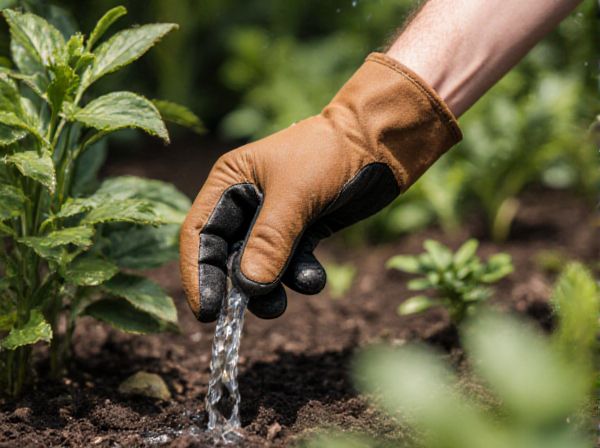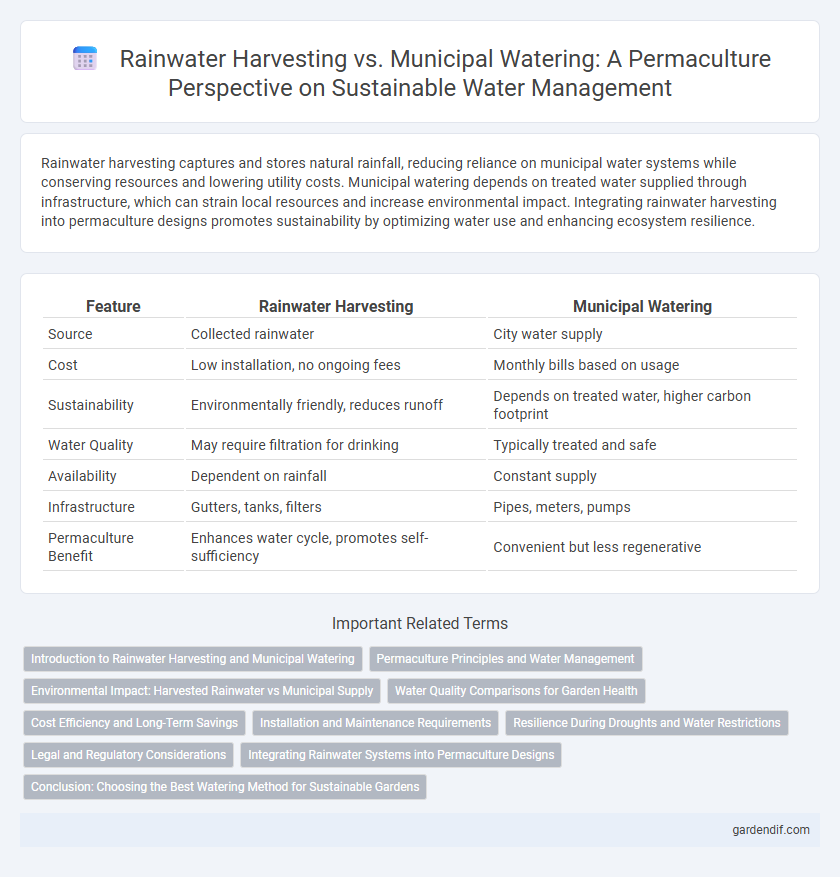
Rainwater Harvesting vs Municipal Watering Illustration
Rainwater harvesting captures and stores natural rainfall, reducing reliance on municipal water systems while conserving resources and lowering utility costs. Municipal watering depends on treated water supplied through infrastructure, which can strain local resources and increase environmental impact. Integrating rainwater harvesting into permaculture designs promotes sustainability by optimizing water use and enhancing ecosystem resilience.
Table of Comparison
| Feature | Rainwater Harvesting | Municipal Watering |
|---|---|---|
| Source | Collected rainwater | City water supply |
| Cost | Low installation, no ongoing fees | Monthly bills based on usage |
| Sustainability | Environmentally friendly, reduces runoff | Depends on treated water, higher carbon footprint |
| Water Quality | May require filtration for drinking | Typically treated and safe |
| Availability | Dependent on rainfall | Constant supply |
| Infrastructure | Gutters, tanks, filters | Pipes, meters, pumps |
| Permaculture Benefit | Enhances water cycle, promotes self-sufficiency | Convenient but less regenerative |
Introduction to Rainwater Harvesting and Municipal Watering
Rainwater harvesting captures and stores precipitation from rooftops or surfaces in tanks, reducing dependence on municipal water systems and promoting sustainable water use. Municipal watering relies on centralized infrastructure delivering treated water sourced from reservoirs or rivers, often involving substantial energy consumption and distribution costs. Implementing rainwater harvesting in permaculture systems enhances water efficiency, conserves resources, and supports ecosystem health by minimizing runoff and erosion.
Permaculture Principles and Water Management
Rainwater harvesting aligns with permaculture principles by enhancing water conservation, reducing reliance on municipal systems, and promoting sustainable land use through natural water cycles. Its integration supports ecosystem resilience and soil health by capturing and reusing local rainfall, which minimizes energy consumption and infrastructure costs associated with municipal watering. Employing rainwater systems enables regenerative water management practices that enhance biodiversity and restore natural hydrological patterns essential in permaculture design.
Environmental Impact: Harvested Rainwater vs Municipal Supply
Rainwater harvesting significantly reduces dependence on municipal water systems, minimizing the energy and chemicals involved in water treatment and distribution. Collected rainwater lowers stormwater runoff, decreasing soil erosion and mitigating urban flooding. Unlike municipal water, harvested rainwater is untreated and free from chlorine or fluoride, benefiting soil health and plant growth in permaculture systems.
Water Quality Comparisons for Garden Health
Rainwater harvesting provides high-quality, soft water free from chlorine, fluoride, and heavy metals commonly found in municipal water, supporting healthier soil microbes and robust plant growth. In contrast, municipal watering often contains chemical additives and fluctuating mineral content that can alter soil pH and reduce beneficial microbial activity. Consistent use of harvested rainwater promotes sustainable garden health by maintaining optimal hydration conditions and minimizing chemical stress on plants.
Cost Efficiency and Long-Term Savings
Rainwater harvesting systems reduce reliance on municipal water by collecting and storing rainwater, significantly lowering water bills and minimizing utility expenses. Installing rainwater tanks and filtration setups requires initial investment but offers long-term savings through decreased water consumption and protection against rate hikes. Municipal watering costs remain subject to fluctuating prices, while harvested rainwater ensures sustainable, cost-effective irrigation ideal for permaculture practices.
Installation and Maintenance Requirements
Rainwater harvesting systems require initial investment in collection surfaces, storage tanks, and filtration units, with routine maintenance involving cleaning gutters, checking filters, and ensuring tanks remain sealed to prevent contamination. Municipal watering relies on infrastructure already in place, minimizing installation efforts but depends on external utility management for maintenance and water quality control. Both methods demand ongoing upkeep, but rainwater systems offer greater autonomy and sustainability benefits within permaculture designs.
Resilience During Droughts and Water Restrictions
Rainwater harvesting enhances permaculture resilience by capturing and storing natural precipitation, reducing dependence on municipal water systems that may face restrictions during droughts. Stored rainwater supports irrigation needs sustainably, maintaining plant health and soil moisture when municipal supplies are limited or rationed. This decentralized water source increases self-sufficiency and helps ecosystems withstand prolonged dry periods more effectively than relying solely on municipal watering.
Legal and Regulatory Considerations
Permaculture practitioners must navigate complex legal frameworks when choosing rainwater harvesting versus municipal watering systems, as regulations vary widely by region and can impact water rights and usage permits. Many jurisdictions impose restrictions on rainwater collection to protect local water sources, often requiring permits or adherence to specific storage standards. Understanding local water laws and environmental regulations is essential for sustainable water management and compliance in permaculture design.
Integrating Rainwater Systems into Permaculture Designs
Integrating rainwater harvesting systems into permaculture designs enhances water efficiency by capturing and storing natural rainfall, reducing reliance on municipal water supplies prone to scarcity and high costs. Strategic placement of rainwater catchment, such as rooftop collection and earthworks like swales, ensures optimal water distribution to support diverse plant guilds and soil health. This sustainable approach aligns with permaculture principles by promoting resilience, conserving resources, and maintaining ecosystem balance without external water inputs.
Conclusion: Choosing the Best Watering Method for Sustainable Gardens
Rainwater harvesting offers a sustainable and cost-effective alternative to municipal watering by reducing dependency on treated water and minimizing environmental impact. Incorporating rainwater systems in permaculture gardens enhances soil health and plant resilience through natural mineral content and balanced pH levels. Prioritizing rainwater harvesting aligns with sustainable garden practices by conserving resources and promoting ecological balance.
Rainwater Harvesting vs Municipal Watering Infographic

 gardendif.com
gardendif.com